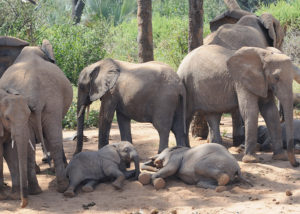
Adult elephants stand guard while young elephants rest in the shade. Photo by Carl Safina: http://beyond-words.net/
The Trump administration is considering elimination of a ban on importation of elephant “trophies.” Administration officials have offered a somewhat dubious rationale that the fees paid by hunters will support elephant conservation efforts. This seems unlikely, as the amount of revenue expected to be raised is a tiny fraction of the cost of conservation. Some thoughts:
- Getting on a plane and flying to Africa to kill large endangered mammals (and make no mistake, pretty much all of the wildlife in Africa is endangered or at least imperiled by habitat loss, agricultural development, and poaching.) with a high-powered weapon from a safe distance seems unsporting and remarkably thoughtless. I suppose I would ask a “trophy hunter,” what did that animal ever do to you? Can you make an elephant? If not, what gives you the right to destroy one?
- These “trophy animals” aren’t paper or plastic targets. Why should they be subjected to pain, distress, and death for some hunters’ momentary excitement?
- Elephants, especially, are intelligent, social animals that communicate with each other, assist each other, take pleasure in the company of others, and grieve the loss of others. Here are some facts about elephants:
- The basic unit of elephant society is a female and her children.
- Elephant families share infant care and child-rearing.
- Elephants maintain extensive social networks, recognizing and communicating with family members and members of other families who live nearby.
- Even in times of distress and danger, elephants behave with kindness and tolerance to their own kind, and maintain family ties.
- Elephants gain status through age. Experience that comes with age determines the survival of elephant families.
- Death of an elephant matriarch threatens the well-being and survival of the entire family unit.
For a thoughtful and riveting account of elephant society, see Beyond Words, by Carl Safina (Holt and Company, NY, 2015).
November 18, 2017